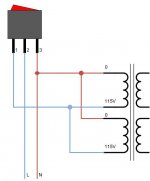yep, no doubt your choice of patterns has to do with habit at your day job and favorite libraries for that where better tools/reflow are more easily accessed.
also I meant rectifier above, not inductor, I had inductance on the brain. the 1210 cap regulator reference bypass and the bridge on the power supply boards I found the most challenging, as its compounded by the direct thermal connection to the solid ground and power planes.
how profoundly does the addition of thermal relief effect impedance at the currents/slewrate we are talking about? I ask this not just for this board, but the PCBs i'm currently working on use solid planes for everything including input and output. they will be reflowed most likely so not such a big deal, but just for curiosity.
also I meant rectifier above, not inductor, I had inductance on the brain. the 1210 cap regulator reference bypass and the bridge on the power supply boards I found the most challenging, as its compounded by the direct thermal connection to the solid ground and power planes.
how profoundly does the addition of thermal relief effect impedance at the currents/slewrate we are talking about? I ask this not just for this board, but the PCBs i'm currently working on use solid planes for everything including input and output. they will be reflowed most likely so not such a big deal, but just for curiosity.
This is how I wired up the switch...
I guess I should ground it to the case.
An externally hosted image should be here but it was not working when we last tested it.
I guess I should ground it to the case.
This is how I wired up the switch...
I guess I should ground it to the case.
Is that the wiring that did not work? Was the bulb constantly lit regardless the switch position? If it was, you were using wrong pair of pins on the switch. Try the center pin and the one on the other side.
There could also be a safety issue with the wiring. You're supposed to put a switch following the Live terminal of the IEC socket, but it seemed in the diagram the switch is on the Neutral.
The ground pin of the IEC socket should be wired to the chassis.
The switch worked (neon bulb) lit when I pushed the rocker up (and off when down).
Just wasn't getting any ac to my transformer from the switch.
I guess I should be using neutral (black) to the switch.
with only two pins on the switch wired up you should never see the light turns on. You were definitely using a wrong pair of terminals.
If your switch is of Defond ARC series, wire Live from IEC to pin 1, Neutral from IEC to pin 3, transformer 115 to pin 2, transformer 0 to pin 3.
ok, here's the switch that's driving me nuts.
An externally hosted image should be here but it was not working when we last tested it.
what size were you using? you might have to look for another reason the fuses are popping ... the current draw on this amp is VERY small; 0.5A @ 120V is 60W, the amp draws less than 5W, and I doubt the inrush current is too huge. I would think 0.2A would be more than enough.
- Home
- Amplifiers
- Headphone Systems
- "The Wire" Ultra-High Performance Headphone Amplifier - PCB's
